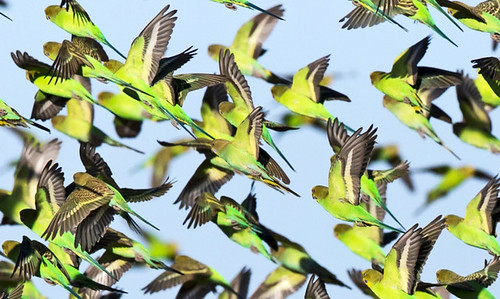 "By having a natural mechanism where populations of birds are predisposed to choosing different flight paths around obstacles, an entire flock could avoid situations where they block each other, slow down, lose time, and expend more energy," says Partha Bhagavatula. (Credit: Jim Bendon/Flickr) New research may clarify how birds fly in flocks without running into each other.
"By having a natural mechanism where populations of birds are predisposed to choosing different flight paths around obstacles, an entire flock could avoid situations where they block each other, slow down, lose time, and expend more energy," says Partha Bhagavatula. (Credit: Jim Bendon/Flickr) New research may clarify how birds fly in flocks without running into each other.
Lead author Partha Bhagavatula of the University of Queensland’s Queensland Brain Institute, says the study found budgerigars (shell parakeets) displayed an individual bias to fly to either the left or the right of objects.
This inbuilt bias would allow flocks to quickly navigate past obstacles by splitting up and not slowing down due to crowding.
“We were looking at how birds decide to navigate because they’re very good at quickly travelling through environments with narrow gaps, such as dense bush, without collisions,” Bhagavatula says.
“By having a natural mechanism where populations of birds are predisposed to choosing different flight paths around obstacles, an entire flock could avoid situations where they block each other, slow down, lose time, and expend more energy.”
Researchers flew the budgerigars down a tunnel where they were met by an obstacle and a choice of two flight paths.
“By giving birds the choice of flying left or right, through a pair of two adjacent openings, we were able to see that they displayed individual preferences,” says Bhagavatula.
He says some birds had no bias and would choose the wider gap every time, while others with a distinct bias preferred going to one side even if it was significantly narrower than the alternative.
“This is very interesting and unexpected—because it’s generally expected for an animal species to have one dominant side that they prefer, such as humans being predominantly right-handed,” says Bhagavatula.
Project leader Professor Mandyam Srinivasan says further studies should be conducted by flying the birds in groups to see how individuals behaved in a group dynamic, and whether they maintained those preferences when flying in a flock.
The findings could have implications for Srinivasan’s work on robotic aircraft.
“The interactions between other aircraft are certainly very important, and when sending up autonomous aircraft without any human guidance it would certainly be worth investigating developing aircraft with individual biases like we see here,” he says.
The Australian Research Council and the Centre of Excellence in Vision Science funded the study, which appears in PLOS Computational Biology.